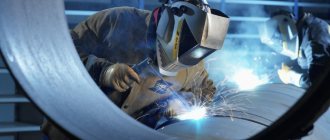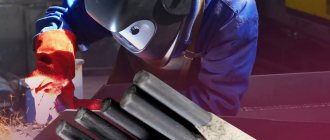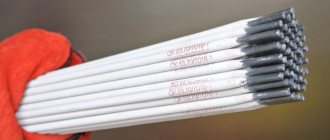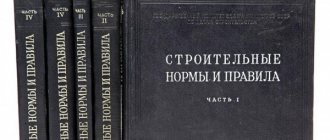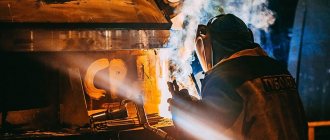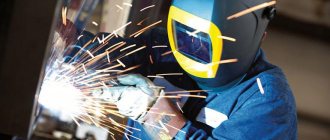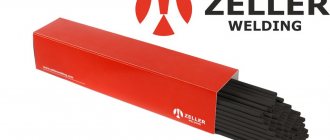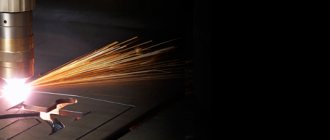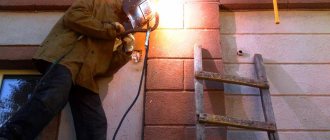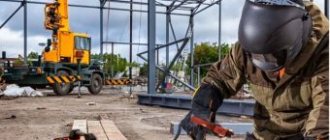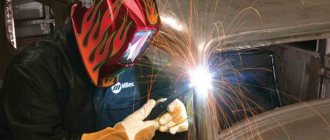Home / Electrodes
Back
Reading time: 3 min
0
2115
In his professional activity, any welder will sooner or later encounter thin sheet metal. This can be any metal sheet with a thickness of up to 2 mm.
It is found quite often, for example, profiled pipes are made from it.
Work of this type is not the most difficult of welding works, it does not require high power of the apparatus and large-diameter electrodes, however, there are nuances that must be taken into account, otherwise the weld will not be of high quality.
In this article we will talk about the intricacies of working with thin sheet metals.
- Welding Features
- Types of arc welding
- Electrodes for welding
- Preparation for welding
- Inverters
- Welding technique
- Working with galvanized steel
- Finally
Welding Features
The main trouble that you may encounter with this type of welding is that a thin metal sheet can burn out when heated.
When heated for a long time, holes may form in it, so you need to cook quickly. Set the current strength to small, it is better to use a short arc.
The inconvenience is that such an arc can go out when separated from the surface, so welding should be done using devices with high current-voltage data.
Also, high temperature can cause wave-like deformation of the sheet, so try not to overheat it.
As we have already said, such welding must be done using a short arc. When choosing electrode rods for welding, you must take into account the type of metal being welded and its thickness.
For example, to weld a sheet with a thickness of 1 -1.5 mm, we take electrode rods with a diameter of 2 mm.
You should try to cook quickly and continuously, without lifting the electrode from the metal, and at the same time, avoiding overheating of the sheet and burning it. The recommended current for such work is 40-60 A.
The best rutile coated welding electrodes
Such rods are used when processing low-carbon and low-alloy steels. The resulting seams are not prone to pore formation and are resistant to hot cracks.
Electrodes with rutile coating have a low metal spatter coefficient, ensure ease of ignition and stable arc burning.
Resanta MP-3
4.9
★★★★★
editorial assessment
93%
buyers recommend this product
See review▶
The main feature of Resant electrodes is the complete absence of cracks after solidification in the metal. The uniformity of the joint prevents the penetration of moisture and ensures high strength of the seam.
The diameter of the rod is 3 mm; it is used to weld material 3-4 mm thick. When using such an electrode, it will be possible to obtain a high-quality seam even on wet, corroded or primed metal.
Advantages:
- minimal splashing;
- ease of re-ignition;
- working with wet surfaces;
- seam strength.
Flaws:
- volumetric slag releases.
Resanta MP-3 is used for welding in conditions of negative temperatures or high humidity.
The resulting seam is resistant to static and shock loads, which will be very useful in the manufacture of large tanks or ship hulls.
Wester MP-3
4.8
★★★★★
editorial assessment
90%
buyers recommend this product
The main features of Wester electrodes include a thin coating and ease of arc re-ignition. This ensures efficient processing of thin sheet metal when frequent stops or long breaks are required.
The electrode diameter is 3 mm, the consumption per 1 kg of deposited metal is 1.7 kilograms. Due to the permissible moisture content in the processed material of 1.5%, such rods can be used to weld moistened and oxidized surfaces.
Advantages:
- easy removal of slag;
- neat seam;
- ease of re-ignition;
- minimal metal spattering.
Flaws:
- requires long-term calcination.
Wester MP-3 are used for manual arc welding of low-carbon steels. They can be used to treat rusty or dirty surfaces.
Quattro Elementi 770-414
4.8
★★★★★
editorial assessment
88%
buyers recommend this product
The electrodes are characterized by a powerful and stable welding arc thanks to the use of a tungsten rod. Their use when processing metal covered with scale or rust prevents the formation of pores and microcracks in the seams.
Element diameter is 2 mm, processing temperature is 170-190°C. High-quality coating and refractory rod guarantee minimal metal loss during operation and resistance to low welding current.
Advantages:
- strong seam;
- smoothness of the connection;
- stable arc burning;
- easy ignition.
Flaws:
- fast consumption.
Quattro Elementi 770-414 are designed for processing thin sheet metal. A good choice for household welding or body repair.
SVEL MR-3C
4.8
★★★★★
editorial assessment
86%
buyers recommend this product
These rods are distinguished by their welding efficiency on short and medium welding arcs. They are recommended for heavy-duty use due to their combustion stability and operation with both direct and alternating current.
The diameter of the rod is 3 mm, which makes it possible to weld metals with a thickness of about 4 mm. Surface treatment is carried out in almost any spatial position.
Advantages:
- deep penetration;
- work in any position;
- low price;
- economical consumption.
Flaws:
- slag splashing.
SVEL MP-3C is worth purchasing for welding in hard-to-reach places or in awkward positions. Electrodes are used when processing critical structures, the inner sides of tanks or wide pipes.
Types of arc welding
We have already described the first option; this is continuous welding, in which the electrode is welded at a constant speed. However, this method is more suitable for experienced welders, since choosing the right speed is not so easy.
If you cook too quickly, the seam will not be cooked along the entire length; if you cook too slowly, the sheet will overheat, become deformed, or a hole will form.
Therefore, the following method is more popular, in which the electrode is periodically removed from the surface. The third method is pointwise.
With this method, cook using light touches. With each of these methods, it is imperative to monitor the temperature in the welding zone and avoid overheating the metal.
additional characteristics
Many other features of the welding carried out determine the requirements for electrodes. An example is the polarity and type of current. The welding inverters used in most cases supply direct current, which can be supplied to the welding zone according to two schemes:
- Reverse polarity involves connecting the plus to ground and the minus to the electrode.
- Straight polarity. In this case, the plus is connected to ground, the minus to the welding electrode.
Reverse polarity is selected in the following cases:
- In order to protect the metal from burn-through, the reverse polarity of the connection is selected. It allows you to work with parts that are small in thickness.
- High-alloy steels are characterized by high susceptibility to heat. That is why, when working with such material, the reverse polarity connection method is chosen.
The most important parameters of the welding process are:
- Diameter of the electrodes used.
- The strength of the welding current used.
- The thickness of the parts to be connected.
It is very important to select the electrode diameter correctly, since if the value is too high, the welding current density is significantly reduced. In this case, the degree of penetration of parts decreases, the width of the weld seam increases and its quality decreases. In addition, manufacturers often indicate what amperage the product is best suited for.
This is interesting: Inch thread: size table, markings, GOST
Electrodes for welding
The choice of electrode rods depends on the characteristics and properties of the metal being welded, such as thickness, melting point.
It is important that the melting temperature of the material being welded is close to the melting temperature of the electrode rod. Above we present you with several tables that will help you choose the right electrode.
If we need to weld low-alloy or carbon steels, then electrodes of the MTG-01K, MTG-03 brands will help us. They can also be labeled as LEZ-MR.
They are undemanding in terms of metal cleanliness and can weld dirty, oxidized, and wet surfaces.
Most often they are used for installation work, for example, welding pipe joints. But do not forget - the result when welding unprepared material will always be worse.
We set the current value based on the thickness of the sheet. The relationship here is direct - the thicker the sheet we cook, the higher the current strength we must set in order to melt it.
Below you can see how the current strength and diameter of the electrode rod depend on the thickness of the sheet being welded.
Which electrodes are best for cooking: choosing the right electrodes
A welding electrode is a relatively small rod that is made from various metals and has electrically conductive properties. Its main purpose is to supply current during welding. The quality of the seam depends largely on the chosen electrode. Considering that there are quite a large number of varieties, the question arises: “which electrodes are best for solving a particular problem?”
Key selection criteria
When choosing which electrode to weld metal with, you need to consider the following parameters:
- Rod diameter.
Selected depending on the thickness of the structure being welded. The thinnest rods have a diameter of 1.6 mm. They are intended for joining sheets no thicker than 2 mm, while rods with a diameter of 5-6 mm allow you to weld sheets up to 13 mm thick.
- Welding current strength.
This parameter is calculated in such a way that for each millimeter of the rod there is about 30-40 Amperes of current. If welding is performed in a vertical position, the current strength is reduced by 15%. - Metal grade.
Each of them has its own unique chemical composition and physical properties. For example, to work with heat-resistant steels, you need to use electrodes that provide a temperature of about 1100°C.
Please note that the welding current should not be too low, as this will cause the tip to stick. If the values are excessively high, the arc will burn well, but in this way the surface of the material can be burned. In this mode, rods with a small diameter burn out very quickly, unable to cope with their task.
It is also important what components the rod coating consists of. As a rule, there are 6-12 of them. In this case, each component is responsible for creating the environment necessary for the formation of strong seams with stable characteristics.
The main ones:
- cellulose layer - creates a cloud of gas with a reducing agent;
- calcium fluoride – makes iron oxides more fusible, and the released gas stabilizes the combustion process;
- carbonates - responsible for the formation of slags;
- ferromaterials (Mg and Si) – deoxidize the seam after welding;
- titanium dioxide - allows the slag to harden, which improves the fluidity of the melt;
- gum with clay elements - makes the coating more durable;
- iron powder – improves the quality of the weld by equalizing the temperature.
It is necessary that the material of the electrodes and the type of metals being welded match their characteristics.
Welding carbon and low alloy steels
In this case, the main role is played by the electrode coating material. So, for welding boiling grades of steel (has a low carbon content and is slightly deoxidized), any coating is suitable. To weld semi-quiet steels, which have large sheet thicknesses, a base or rutile coating is required. When welding structures made of mild steel at low temperatures or under dynamic loads, electrodes with a basic coating are also used.
Unstable arc combustion can deteriorate the quality of the seam and will not allow normal welding of metal structures using alternating current. The arc burns best in the presence of cellulose, acid and rutile coatings. In this case, you can use welding transformers. In addition, you need to thoroughly clean the welded edges from rust, oil and dirt in order to avoid the formation of steam.
How to weld and surfacing cast iron
The procedure allows you to eliminate defects in cast iron castings, as well as restore damaged parts that have exhausted their service life. The result is steel, various alloys based on copper, nickel, etc. Models of the TsCh-4, OZCH-2, OZCH-6 and similar brands cope best with the above task. In some cases, for example, during the repair of cast iron tubes with heavy contamination and high humidity, it is advisable to use the OZL-25B, OZL-27 and OZL-28 grades.
Welding of non-ferrous metals
Each of these metals has its own melting threshold and physical and chemical properties. For example, intense oxidation does not allow welding of titanium and its alloys. In the case of aluminum, the process is complicated by the oxide film, which melts at a temperature of 2060°C, and in order to melt the aluminum itself, 660°C is enough. The film formed due to the oxide can lead to disruption of the integrity of the seams and a decrease in their strength. It is removed by adding chloride and fluoride salts of alkali and alkaline earth metals.
Copper also has its own problems when welding - pores form in the weld under the influence of gas bubbles (especially oxygen and hydrogen). To avoid this, the copper must be well deoxidized, and the edges must be thoroughly cleaned before welding begins. In turn, bronze is highly brittle, and nickel and its alloys are sensitive to gases dissolved in the weld pool - nitrogen, oxygen and hydrogen. As a result of this process, hot cracks and pores appear in the metal structure.
Metal cutting
Arc cutting of metal structures is used for installation and repair of various metal structures. It is not very efficient; you should not expect a “beautiful” seam from it, or an accurate cut.
However, this cutting method does not require additional equipment or highly qualified workers. It is easy to learn for a beginner. Cutting by electric arc welding is often used in training, in particular in mastering the principles of working with an inverter. This method is often used by home craftsmen for inexpensive metal cutting.
Welding alloy steels with increased heat resistance
Alloyed heat-resistant steels are welded with special electrodes that provide a certain heat resistance of the welded joints.
The resulting structure must withstand significant mechanical loads and high temperatures. The likelihood of cracks forming due to temperature changes is also minimized. Thus, at temperatures up to 475°C, models made of molybdenum like E-09M are used, and at temperatures up to 540°C, models with a high content of chromium and molybdenum (E-09MH, E-09X1M, E-09X2M1 and E-05X2M) are used. . E-10Kh5MF has a high chromium content, which makes it possible to weld steel structures with the appropriate chemical composition.
What electrodes should be used to cook high-alloy steel?
Such steels contain 13% chromium and have anti-corrosion properties. In this case, the metal seam must be resistant to atmospheric precipitation in slightly aggressive environments, heat-resistant (maximum temperature 650°C) and heat-resistant (maximum temperature 550°C).
Models of type E-12Х13 of brands LMZ-1, ANV-1, etc. have such properties. If the steel has a low carbon content and there is nickel alloying, preference is better to give to products under the index E-06Х13Н. If you need to weld steel sheets containing 25% chromium, options like E-08X24N6TAFM are best, making the finished weld ductile, impact-resistant and corrosion-resistant.
Welding of dissimilar steels and alloys
We are talking about steels and alloys that have unique physical and mechanical properties, chemical composition, and weldability. Such steels can be carbon and alloyed, high-strength, heat-resistant, and also high-alloy.
Welding steels and alloys with dissimilar structures also has a number of characteristic features. To avoid the formation of cracks, areas with an inhomogeneous structure at the melting site, as well as excessive growth of residual stresses, models like ANZHR-1, OZL-27, NIAT-5, EA-395/9, OZL-25B, IMET-10 and TsT- are used 28 with special properties.
Welding machine compatibility
When choosing which electrodes to weld steel with, it is necessary to take into account not only the type of material for which they are intended, but also the features of the welding machine.
Of course, in theory and in practice, the owner of an electric arc machine can use any electrode. However, in reality there are devices that are better suited for use with rods of a certain type of coating (for example, IN226 CEL - excellent for cellulose-coated electrodes).
In addition, welding machines have a current limitation. This range imposes its own limits on the use of diameter electrodes. How to determine if consumables are suitable? Just look at the table below:
Now you are more familiar with electric arc welding and some of the nuances of choosing welding electrodes. We advise you to read other articles in this section to gain useful knowledge about welding processes, materials and important nuances for improving the quality of welding work.
Preparation for welding
The surface of thin-walled metal must be pre-treated to a shine using sandpaper or a grinding machine.
To obtain the best result, surfaces must be degreased with a solvent. The better we prepare the surface, the better the quality of the seam we will get.
After cleaning, place the sheets on a flat surface, avoiding gaps between them, and fix them in this position.
For this purpose, clamps of all types are used. Then use small seams every 10 cm to connect the parts.
This will prevent thin-walled surfaces from shifting or bending. The final welding can now be carried out.
Direct or alternating current
In order to correctly select electrode products, you need to know what type of current the welding process is possible with. In other words, what is better - “constant” or “change”? There are also universal brands that work on both types of current.
Electric welding with inverters using direct current has its own characteristics and advantages:
- There is practically no metal spattering (this saves electrodes);
- ease of use;
- high productivity due to reduced labor intensity;
- persistent and stable arc even in the presence of external negative influences: voltage fluctuations or gusts of wind;
- neat and high quality seam. There are no uncooked areas;
- ability to work with thin metal products.
There are also disadvantages:
- work is possible only with the use of expensive inverter technology;
- unstable arc in difficult places. For example, in the corners.
Two operating modes are possible: with direct or reverse polarity. The first option is used when working with thick metal and when high temperatures are required. Reverse polarity currents are convenient for connecting thin and low-melting metals, as well as dissimilar alloy and stainless steels.
Electric welding with alternating current does not require a rectifier. In addition, such electrodes are universal: they also work with direct current.
Minuses:
- worse connection quality than when using “permanent”;
- low impact strength;
- uneven seam;
- metal splashing.
Inverters
Inverter-type machines are best suited for welding thin sheet metals. A properly configured inverter will help you achieve good results.
The advantage of such devices is that we can work by setting them to reverse polarity. In this case, the electrode heats up more, and the metal is weaker, which reduces the risk of burning it.
For high-quality inverter welding, it is recommended to use electrode rods with a diameter of 1.5 - 2 mm, with a sufficient melting coefficient.
The current must be set to 30-45 A for 1.5 mm and 40-60 A for 2 mm. To reduce the heating of the surfaces to be welded, they must be installed vertically, at an angle of 30-40 degrees, and welded from top to bottom.
Classification according to main characteristics
The consumable material in question is primarily classified according to its intended purpose. There are several main groups of electrodes:
- Designed to work with metals that have a low concentration of carbon and alloying elements.
- For joining heat-resistant steels with a high strength index.
- For working with high-alloy steels, for example, stainless steel, in which the concentration of chromium is high.
- Options designed to work with aluminum or copper.
- A separate group includes electrodes intended for connecting cast iron elements.
- For repair work and metal surfacing.
- Universal type products that are used to work with materials of uncertain chemical composition.
A wide variety of chemicals can be applied to the metal rod. According to the type of coating used, 4 groups of products are distinguished; only two are most widespread:
- Main. Products with a basic coating are widely used. An example would be electrodes of the UONI 13/55 brand. They are used to produce seams with high impact strength, mechanical strength and ductility. In addition, the base coating helps protect the seam from the occurrence of crystallization cracks. The choice of this design option is carried out if you need to obtain a responsible design. A significant drawback is that before welding work, the surface must be thoroughly cleaned: oil stains, rust, and scale can cause the formation of microscopic pores.
- Rutile coating. If it is necessary to make a connection on low-carbon steel, then rutile-type electrodes are often chosen. Let's call the most common brand MP-3. The second type is characterized by easy separability of the forming slag and arc stability when supplied with alternating or direct current. During the welding process, less spatter is generated, and the resulting seam has excellent decorative qualities. In addition, the second type of product is suitable for working with workpieces that have a large layer of rust or contaminants on the surface.
The other two types are extremely rare, as they are used in special cases.
Welding technique
For each individual case, a different welding technique is used; you choose it yourself, guided by your experience. Here are some methods.
Sorting. With this method, the edges of the sheet are bent and the metal is fastened with transverse seams at intervals of 5-10 cm. Then we weld the parts in a continuous movement from top to bottom.
This method requires sufficient experience; when applying a continuous seam, burning of the sheet is possible.
To avoid this, it is recommended to tear off the arc for a short time, allowing the part to cool, then lower it, moving it a few millimeters. The main thing is that the metal does not have time to cool down too much.
Butt welding. This is a rather complex method; it is easier to overlap weld. However, if you decide to weld using this method, a wire placed between the sheets to be welded can make the task easier.
The welding arc must be guided along the wire; it will take the entire temperature load on itself, and the sheets will not overheat. A replacement for wire can be copper plates.
They must be placed under the surfaces to be welded. Copper has high thermal conductivity, heating up faster than the metal, it will not allow it to overheat.
Main selection criteria
Difficulties that arise when choosing are associated with the emergence of a large number of different electrode options. When searching for the most suitable electrode, you should take into account their division into two main groups:
- Melting.
- Non-melting.
The first type of product is represented by a rod of various diameters with a coating made from a special mixture.
Due to the use of a special coating composition, the created arc behaves better at the time of welding. This is why consumable electrodes are often chosen for devices used in manual arc welding. Non-consumable - today are less common, as they are intended for welding work in a special environment. A beginner will not be able to choose them correctly, as they have a large number of features.
The selection of electrodes for welding with an inverter is carried out taking into account the material from which the workpieces to be joined are made. The properties of the metal largely determine the quality of the resulting weld.
Considering how to choose welding electrodes for an inverter, we note the following points:
- The rod for transmitting electricity and stabilizing the arc is selected for each material, taking into account its chemical composition.
- Carbon electrodes are used to connect products made of low-carbon or low-alloy steel.
- If the products to be joined are made of alloy steels, then electrodes of the MP-3, ANO-21, LB-52U and others are used during welding work.
- The best electrodes for inverter welding of other types of metal are considered to be those in the manufacture of which a core made of alloy steel is used, for example, TsL-11.
- The welding method can be used to join elements made of cast iron. In this case, OZCH-2 electrodes are used.
Experienced welders select the consumable material in question also taking into account the conditions under which the resulting product will be used.
Working with galvanized steel
Welding thin-walled galvanized steel, or galvanized steel as it is called, causes welding difficulties. What is galvanized steel? Ordinary steel, as a rule, is sheet, with a zinc coating, which creates difficulties during welding.
The zinc coating does not allow making a high-quality seam, so it must first be removed from the edges.
This is done using sandpaper, a grinder, an angle grinder, or a metal brush.
An important condition for such work is that cleaning must be done outdoors or in a well-ventilated room. During stripping, zinc can evaporate and its fumes are toxic.
Fulfillment of all the listed conditions - the correct selection of equipment and components, an optimally configured machine, a successful choice of welding method, compliance with the rules of safe welding - all this will help you achieve the desired result.
What is an electrode and what is the coating for?
An electrode is a piece of metal wire with a special coating - coating. During welding, the core melts due to the temperature of the arc. At the same time, the coating burns and melts, creating a protective gas cloud around the welding area - the weld pool. It blocks access to oxygen contained in the air. As the coating burns, part of it turns into a liquid state and covers the molten metal with a thin layer, also protecting it from interaction with oxygen. So the coating ensures good quality of the seam.
The welding electrode consists of a core and a protective coating
Before starting welding, any electrode is inspected: the coating should not be chipped. Otherwise, you will not achieve uniform heating and a high-quality seam. Also pay attention to the tip of the electrode: the thickness of the coating should be the same on all sides. Then the arc will come out in the center. Otherwise it will be displaced. For experienced welders this is not a big deal, but for beginners it can create significant problems.
It is necessary to monitor the moisture content of the coating. Some of them ignite very poorly in high humidity (for example, SSSI). Due to such “capriciousness” of the coating, they need to be stored in a dry place, ensuring as airtight packaging as possible. You can put the box in a bag, and also put in a few bags of salt that come in shoe boxes.
You should not buy wet electrodes: they can, of course, be dried, but their characteristics will decrease. If it does happen that the electrodes become damp, you can dry them in a regular household oven at low temperatures (they are usually indicated on the packaging). The second way is to put it in a dry, well-ventilated area for a long time.
Coating (protective coating) of electrodes can be: basic, rutile, cellulose and acidic.
Types of coating and their characteristics
There are only four types of coatings:
- Basics.
- Rutile.
- Sour.
- Pulp.
Basic (USSI) and cellulose coatings are only suitable for DC welding. They can be used on critical seams: they create a strong, elastic seam that is resistant to impact loads.
There are more than 200 brands of electrodes for welding, about 100 of them can be used in manual arc welding
The other two (rutile and acidic) can work with both alternating and direct current when welding. But acidic coating is very toxic: you can work indoors only if the workplace is equipped with forced exhaust.
Rutile coating has a greenish or blue tint, the electrodes are easy to ignite. They ignite well even if the inverter has a low open circuit voltage (for reliable ignition of the main coating, a good current-voltage characteristic is required; how to choose an inverter welding machine, read here.). When welding with rutile electrodes (MP-3), the metal hardly splashes, but there is a lot of slag and it is not easy to remove: you have to work with a hammer.
You may be interested in how to weld a gazebo from a metal pipe or how to make a shed on a pipe frame.
This is interesting: Corrugated stainless pipe: production and application features
Differences in electrodes by brand and diameter
There is an opinion among experienced welders that when using an inverter, you can weld with any electrodes. As a rule, such an opinion is based only on the personal experience of such specialists engaged in performing work of a certain type (welding structures from profile pipes or angles). When performing work using an inverter, no serious requirements are placed on the connection regarding its tightness, so electrodes with a diameter of 0.5–2 mm can be used without problems.
The choice of diameter and brand of electrode should be based on the thickness of the metal that needs to be connected with them. Parts of large thickness require long-term welding; accordingly, the electrode for welding them must be selected with a larger diameter. You still need to learn how to work with small-diameter welding electrodes; they burn out very quickly. Typically, such products are used for tack work.
» data-lazy-type=»iframe» src=»data:image/gif;base64,R0lGODlhAQABAIAAAAAAAP///yH5BAEAAAAALAAAAAABAAEAAAIBRAA7″>
Which electrodes are best to choose is also influenced by the type of work for which they are planned to be used. Thus, to perform complex route work, it is necessary to select electrodes of large diameter, and the installation of structures from profile elements can be carried out with products with a diameter of up to 2 mm. These electrodes are used, in particular, in the installation of sectional doors and the manufacture of various enclosing structures from profile pipes and corrugated sheets.
How to choose the best electrodes for inverter welding
Experienced professionals recommend the following brands:
Calcium fluoride coating
- ESAB;
- SSSI 13/55.
Rutile layer
- AHO-4;
- MP-3;
- OK 46.00.
Stainless steel
- NZh-13;
- OZL-8;
- TsL-11.
We told you how a novice master can choose suitable consumables, gave instructions on which options to choose if you cannot yet assess the situation from the height of your own experience, and told you how to choose a certain electrode diameter. We hope our recommendations will allow you to do the job efficiently and help you further improve your skills. is engaged in the sale of bandsaw machines; for individual consultation, please contact our managers at the contact numbers listed on the page.
Coatings
Manufacturers often apply special coatings to electrodes to improve their performance. Among the most common coatings are basic and rutile. The base coating is the most popular and is used by a large number of manufacturers. Thanks to him, it is possible to obtain a high quality seam. Well, in combination with the correctly selected electrode diameter and extensive experience, the welder is able to make a weld of the highest quality and weakly subject to mechanical stress.
Rutile coating is popular among craftsmen working with low-carbon steel. Thanks to this coating, the formation of pores in welds is eliminated; such electrodes can be used with alternating and direct current, and can be reused. Also, electrodes with rutile coating are simply more convenient to use when performing work in hard-to-reach places; when melted, such a coating does not emit hazardous substances (unlike other coatings), which allows you to maintain health.
